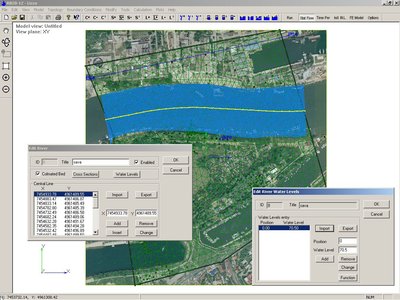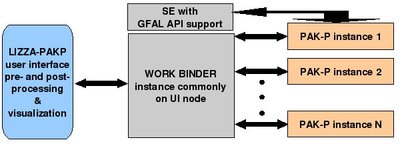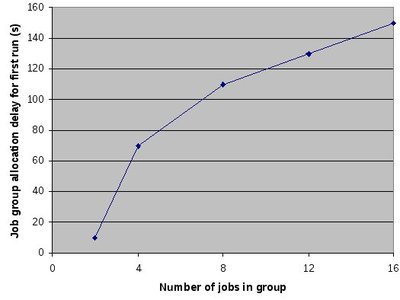Lizza-PAKP is a groundwater flow simulation system which consists of solver based on finite element method (PAKP) and user interface (Lizza). It was developed in cooperation between Institute for Water Resources "Jaroslav Cerni", Belgrade and Bioengineering Research and Development Center - BioIRC, Kragujevac, Serbia. It provides full 3D modeling capabilities, stationary and non-stationary modeling, saturated and non-saturated environment calculation, as well as mass and heat transport handling. PAKP module incorporates a solver based on MPI paradigm, making its presence a grid site requirement. The application also provides WorkBinder interface (service developed by UOB as multi-application interactive job environment), which helps in hiding grid complexity from the end user.

Contributors
- Bioengineering Research and Development Center - BioIRC, Kragujevac (RS)
- Institute for Water Resources "Jaroslav Cerni" (RS)
-
Time plan
M3 - Testing cluster mode
M5 - Developing grid mode
M7 - Testing grid mode
M10 - Deployable
M11 - Presentable -

Usage scenario
Main application features are:
- Groundwater transfer through porous medium finite element modeling using Grid infrastructure
- Complete self-contained solution including pre/post processing and visualization features
- Regional and detailed model
- Ranney and tube wells
- WorkBinder interface (application service obtained by UOB) included in order to hide grid complexity
- Finite element solver employs MPI for huge models
User forms arbitrary shaped 3D model specifying data in a way usual in hydrological practice (terrain contours, bottom surface contours, layer material characteristics, characteristics of river-beds). Boundary conditions contain specified levels, flow rates and wells (tube and Ranney kinds). Input data format is simple application specific CSV, while background maps and textures are standard bitmaps.

After the model analysis on the grid infrastructure is performed, PAKP output contains file(s) stored at Storage Elements using LFC(Logical File Catalog) which complies with standard UNV format commonly used in FE analysis. Despite this fact, Lizza itself seems to be the best post-processing, visualization and graphing tool to answer postprocessing and visualization requirements.
The most resource demanding phase in Lizza-PAKP is FE analysis itself, therefore the origin of its HPC orientation. The memory requirement is at least 2GB/CPU core, even for small models. Site MPI support is recommended, but not a strict requirement. In case that Lizza-PAKP run on a site without MPI support, the user is limited to small and not very useful hydrological models.
Results and Outcome
The application introduces innovative solutions compared to similar software packages, intended to simulate Ranney wells, including regional and local models, together with user-friendliness and grid complexity hiding thanks to Work Binder service.
It has already been used to successfully model Belgrade Water Supply Center. Obtaining groundwater flow dynamic parameters is of the highest importance in the business of drinking water supply, management and planning.
Performance
Since MPI enabled FE solver incorporated into Lizza-PAKP is very similar to CFD solver which is a part of SEE-GRID-2 application PBFS, the main objective of performance analysis was not measurment of solver performance, but brand new WorkBinderservice interface.
One of the important features of Lizza-PAKP is a parametric study, where WorkBinder service plays important role, providing WNs from the pool. This performance test stresses the infrastructure in order to provide the relationship between number of jobs in the group and job group allocation delay. Application uses groups of jobs in series of runs and the jobs are requested until a group of desired size is created with 10s delay between successive tries.

There is no delay when there is already a sufficient number of jobs in the pool, as in the case with 2 jobs, and after first series invocations. The delay is only noticed during warming up from idle mode with insufficient initial number of jobs. WorkBinder adapts well to the increasing number of requested jobs, but is limited by the number of free nodes in underlying grid infrastructure.
As soon as Work Binder MPI support becomes available, the performance similar performance analysis will be done in order to test new feature.
Improvements
Already mentioned MPI support inside Work Binder will have significant impact on Lizza-PAKP grid usage. As soon as it becomes available, Lizza-PAKP WorkBinder interface will be modified according to the implementation.
Lizza-PAKP is not a finished software project. It is still under active development according to to the needs of “Jaroslav Černi” use cases requirements.
Deployment and support
Being a part of Environmental VO, Lizza-PAKP provides per site installation scripts enabling members of ENV, SEEGRID and AEGIS VO to use it without manual transfer of executables/libraries.
The application runs in 2 modes - (1) using pure WMProxy and (2) using WorkBinder in order to get sufficient number of WNs. In the pure WMProxy mode, MPI can be enabled or disabled, according to specific site support. In WorkBinder mode, MPI is disabled by default, but requires an instance of WorkBinder supporting Lizza-PAKP application inside the configuration.
Application usage monitoring is achieved by addition of a special VO group. User support is currently limited to mailing lists with correspondents from Bioengineering Research and Development Center - BioIRC and “Jaroslav Černi” institute, but as the application gains popularity, it will surely be expanded.
Licence
LIZZA is free software: you can redistribute it and/or modify it under the terms of the GNU General Public License as published by the Free Software Foundation, either version 3 of the License, or (at your option) any later version.
LIZZA is distributed in the hope that it will be useful, but WITHOUT ANY WARRANTY; without even the implied warranty of MERCHANTABILITY or FITNESS FOR A PARTICULAR PURPOSE. See the GNU General Public License for more details.
You should have received a copy of the GNU General Public License along with LIZZA. If not, see: http://www.gnu.org/licenses/
Download
*to access the content please register and login to this site
WODA
WODA (Well Outline and Design Aid) is a simulator of variably saturated well-driven groundwater flow in an anisotropic discontinuous environment with miscible displacements, heat transfer, variable density, sorption, degradation etc. It is developed at the Group for Numerical Analysis.
WODA does not have its own graphical user interface, but it can work with groundwater models constructed using Lizza.
Contact
This email address is being protected from spambots. You need JavaScript enabled to view it.
